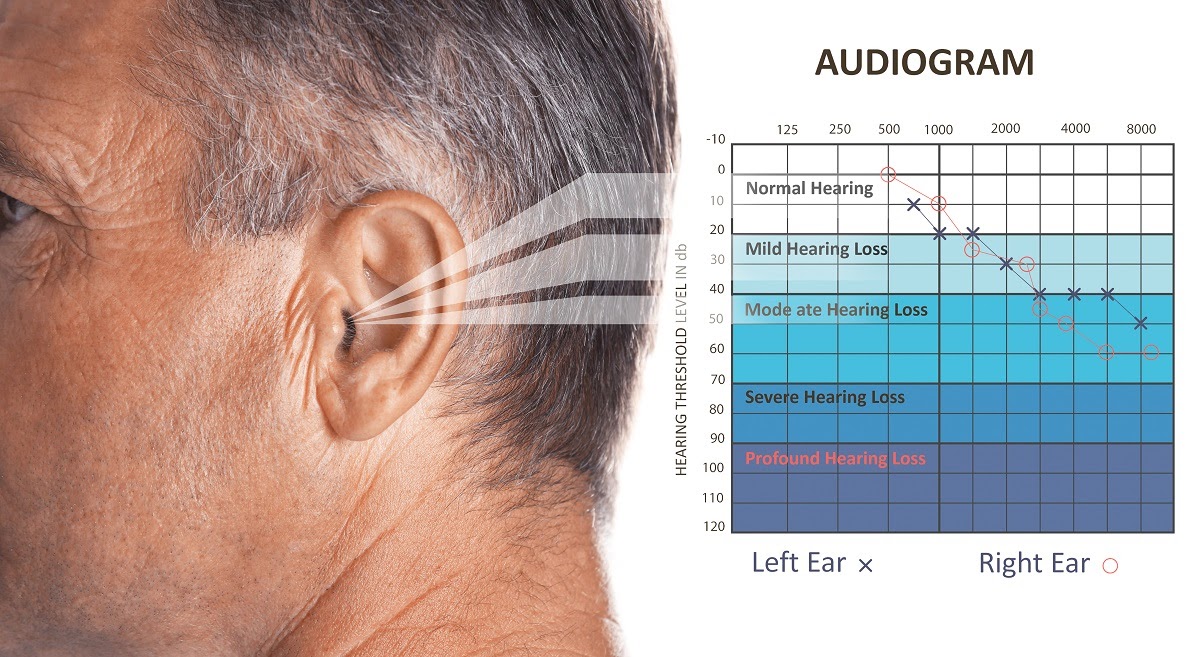Hearing loss affects around 15% of American adults. A hearing screening test can tell you if you have any hearing impairment and, if so, what level of hearing loss you are experiencing.
For the hearing screening test, you will wear headphones and listen to short tones or speech. The audiologist will play the sounds at different volumes into each ear. They will then ask you to indicate when you hear a sound by pressing a button. Typically, the test takes around 30 minutes.
Afterward, your audiologist will give you the hearing test results in the form of a chart called an audiogram. We’ll explain what an audiogram is, how to read the results, and the degrees of hearing loss you may experience.
What Is an Audiogram?
Audiology testing measures your hearing ability in each ear. It gauges how well you can hear a range of frequencies at varying volumes. Your audiologist will give you a chart, known as an audiogram. This will show the results for both your right ear and left ear.
The audiogram is a graph with lines and symbols. The numbers across the top of the graph represent low frequency to high frequency sounds. Down the left side of the graph, you will see a measure of volume, or loudness, with the softest sound at the top and the loudest at the bottom.
Let’s take a closer look at loudness and frequency.
Understanding Loudness
Loudness — or volume — is a sound’s intensity on a scale from quiet to loud. The scale of measurement is decibels (dB). The typical audible range for loudness is from 0 dB to 180 dB. Here are some examples of well-known sounds and their loudness levels:
- Chainsaw: 120 dB
- Auto horn: 110 dB
- Power mower: 90 dB
- Air conditioning unit: 60 dB
- Conversation at home: 50 dB
- Rustling leaves: 20 dB
Understanding Frequency
Another word for frequency is pitch — the highness or lowness of a sound. Think of singers in a choir. A soprano has a high pitch, and a bass singer has a low pitch.
The measurement of frequency is hertz (Hz). A hearing screening test measures frequencies from 250 Hz to 8,000 Hz. This range encompasses the spectrum of the human voice, so being able to hear within this range is important for communication.
The typical hearing frequency range of a healthy young person is about 20 Hz to 20,000 Hz. As you age, you gradually begin to lose the ability to hear the upper range of frequencies.
How to Read an Audiogram
When you look at your audiogram, it will show you the softest volume you can hear at different frequencies. Either an X or an O will mark those points on the audiogram graph. The X’s represent your left ear, and the O’s represent your right ear.
For example, if you can hear a 250-hertz sound at 25 decibels in your left ear, you will see an X where those two lines intersect on the graph. Then, a line will connect each X on the graph. As the line goes up and down, it tells you at which frequencies your hearing is better or worse. A line will also connect the O’s that represent the hearing in your right ear.
The audiogram graph shows both lines. If the lines for both ears overlap, this is what’s known as symmetrical hearing loss, meaning your hearing loss is the same in both ears. If the lines don’t overlap, it’s called asymmetrical hearing loss, meaning you have a different degree of hearing loss in each ear.
The decibel ranges where the X’s and O’s appear on the chart will indicate your degree of hearing loss for that ear: slight, mild, moderate, severe, or profound.
The Degrees of Hearing Loss
When you’re reading your audiogram, these are the degrees of hearing loss your results may indicate.
Slight Hearing Loss
With slight hearing loss, you will hear sounds beginning around 20-25 dB. The effects are subtle, but you may have difficulty hearing faint speech or hearing slight distinctions in sounds. The level of hearing loss is usually not treated in adults, but you might consider natural methods for improving your hearing. However, if your child has slight hearing loss, your audiologist will prescribe hearing aids to help them with developing language and speech skills.
Mild Hearing Loss
At this hearing level, the X’s or O’s on your audiogram will be between 25 dB and 40 dB. With mild hearing loss, you may have some difficulty hearing someone who is talking to you if there is background noise. At times, you may feel as though people are mumbling. Soft consonants and sounds — such as sh, s, k, and f — may also be difficult to hear.
If you have mild hearing loss, you should talk to your audiologist about how hearing aids can help. With hearing aids, you will be able to follow conversations more easily. You will also be able to hear soft sounds more clearly.
Moderate Hearing Loss
If you have moderate hearing loss, you will be unable to hear sounds below the 40-70 dB range. You may find that you are frequently asking people to repeat themselves or have difficulty with conversations over the telephone. In addition to having difficulty hearing consonants, you will miss some vowel sounds, making it hard to understand what is being said.
If left untreated, moderate hearing loss can have a significant impact on your life. Fortunately, with the use of standard hearing aids, you will be able to follow conversations. An audiologist can help you choose the right hearing aids for moderate hearing loss.
Severe Hearing Loss
With severe hearing loss, your audiogram will show X’s or O’s within the range of 70-90 dB. At this level of hearing loss, you will be unable to hear people speaking and may rely on reading lips to follow a conversation. However, you’ll still be able to hear loud sounds, such as fireworks.
Hearing aids can help with severe hearing loss. You can customize them with a telephone switch to filter out background noise or directional microphones. Directional microphones are beneficial in a noisy environment because they can pick up sounds from an assigned direction. This makes it easier for you to hear someone who is talking to you.
Profound Hearing Loss
At this level of hearing loss, your audiogram will show X’s or O’s in the 90-120 dB range. At this level of hearing loss, soft noises will no longer be audible, and you will only be able to hear very loud noises. Conversations will be impossible to follow without the help of a hearing aid, and you may even find sign language helpful.
A cochlear implant is sometimes used to treat profound hearing loss. This is a small, electronic device designed to give the user a sense of sound and to understand speech. The implant has external and internal parts. The external part hooks behind the ear and contains a microphone, transmitter, and speech processor. The internal part consists of a receiver implanted beneath the skin and electrodes in the ear canal near the eardrum.
The implant bypasses damaged hair cells within the cochlea and stimulates the auditory nerve. This improves the signals sent to the brain. It does not restore normal hearing. Instead, it allows the user to have better word recognition. It is particularly helpful for people with hearing loss that are not helped by using hearing aids.
Get Your Hearing Test Results
A hearing screening test will measure your ability to hear frequencies at different loudness levels. A chart known as an audiogram will report your hearing test results. It will show you if you’re experiencing hearing loss and to what extent. Once you know your degree of hearing loss, you’ll be able to seek proper treatment.
If you’re having hearing problems, you can get tested today for free with FreeHearingTest.org’s phone-based hearing screening test. It takes less than five minutes to complete, and the results are available immediately in an easy-to-read chart. You can also take a free online hearing test from MDHearingAid and receive a free consultation with an audiologist.

Doug Breaker
Doug is the CEO of MDHearing.com, a leading direct to consumer seller of hearing aids. MDHearing launched FreeHearingTest.org with the mission to offer free hearing screening tests to everyone, and free hearing aids to those in need.




